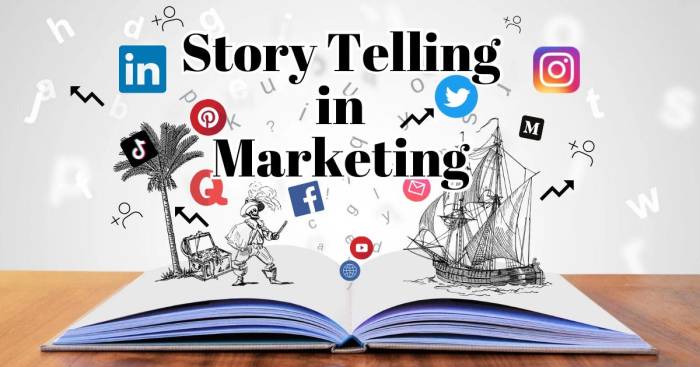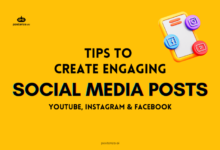
The power of storytelling in digital marketing unfolds a captivating narrative that delves into the essence of connecting with audiences through compelling stories, ultimately leading to marketing success.
Exploring the key elements and strategies in digital storytelling, this topic highlights the impact of narratives on consumer behavior and brand recognition.
Importance of Storytelling in Digital Marketing

Storytelling is a powerful tool in digital marketing as it allows brands to connect with their audience on a deeper level, evoke emotions, and create memorable experiences. By crafting compelling narratives, brands can differentiate themselves in a crowded market and leave a lasting impression on consumers.
Examples of Successful Digital Marketing Campaigns
- Apple’s “Shot on iPhone” campaign: Through user-generated content showcasing the quality of iPhone cameras, Apple effectively tells a story of creativity and innovation, fostering a sense of community among iPhone users.
- Dove’s “Real Beauty” campaign: Dove’s campaign challenges beauty standards and empowers women by telling stories of real women and promoting self-acceptance, resonating with a wide audience.
- Coca-Cola’s “Share a Coke” campaign: Coca-Cola personalized their products by featuring people’s names on their bottles, encouraging consumers to share a Coke with loved ones and creating a sense of connection and nostalgia.
Creating Emotional Connection with the Audience
Storytelling helps in creating an emotional connection with the audience by tapping into their feelings, values, and beliefs. When a brand shares a compelling story that resonates with the audience on a personal level, it can evoke emotions such as joy, nostalgia, empathy, or inspiration. This emotional connection builds trust, loyalty, and a sense of belonging among consumers, leading to long-lasting relationships with the brand.
Enhancing Brand Recall and Recognition
Storytelling plays a crucial role in enhancing brand recall and recognition by making the brand more memorable and distinctive in the minds of consumers. When a brand tells a story that is authentic, engaging, and relatable, it creates a strong impression that is likely to be remembered. By associating the brand with a compelling narrative, consumers are more likely to recall the brand when making purchasing decisions and differentiate it from competitors in the market.
Elements of a Compelling Story in Digital Marketing

In the realm of digital marketing, a compelling story is essential to capture the attention of the audience and foster engagement. Several key elements contribute to making a story compelling in the digital marketing context, including characters, plot, conflict, visuals, multimedia elements, authenticity, and relevance.
Role of Characters, Plot, and Conflict
- Characters: Introducing relatable and well-developed characters in a story can help create an emotional connection with the audience. By incorporating characters that resonate with the target demographic, brands can establish a more personal and engaging narrative.
- Plot: A strong and coherent plot is crucial for maintaining the audience’s interest throughout the storytelling process. The plot should have a clear beginning, middle, and end, with a compelling narrative arc that keeps the viewers intrigued.
- Conflict: Introducing conflict in a story adds tension and drama, making the narrative more dynamic and engaging. Whether it’s a challenge to be overcome or a problem to be solved, conflict can drive the story forward and capture the audience’s attention.
Incorporating Visuals and Multimedia Elements, The power of storytelling in digital marketing
- Visuals: Visual elements such as images, videos, infographics, and animations can enhance the storytelling experience by appealing to the audience’s visual senses. They help in making the story more vivid, memorable, and impactful.
- Multimedia Elements: Incorporating multimedia elements like sound effects, music, and interactive features can further elevate the storytelling experience. These elements can create a multisensory experience for the audience, making the story more immersive and engaging.
Maintaining Authenticity and Relevance
- Authenticity: Authenticity is key to building trust and credibility with the audience. Brands should ensure that their storytelling is genuine, transparent, and aligned with their values and identity. Authentic stories are more likely to resonate with the audience and establish a lasting connection.
- Relevance: To keep the audience engaged, storytelling in digital marketing should be relevant to the brand, the target audience, and current trends. By staying current and adapting to the changing landscape, brands can ensure that their stories remain impactful and resonate with the audience.
Strategies for Implementing Storytelling in Digital Marketing
Implementing storytelling in digital marketing involves developing a cohesive strategy that resonates with the target audience, selecting appropriate storytelling formats for different channels, and measuring the effectiveness of the campaigns.
Developing a Storytelling Strategy for Digital Marketing
To develop a storytelling strategy for digital marketing, follow these steps:
- Identify the brand’s unique story and values that align with the target audience.
- Create buyer personas to understand the demographics, interests, and pain points of the target audience.
- Select the most suitable digital channels based on where the target audience is most active.
- Develop a content calendar to plan the storytelling journey and maintain consistency.
- Integrate storytelling elements such as characters, conflict, and resolution into the digital content.
Importance of Knowing the Target Audience When Crafting a Story
Crafting a story tailored to the target audience is crucial because:
- It creates a connection and builds trust with the audience.
- Helps in delivering personalized and relevant content that resonates with their needs.
- Increases engagement and conversions by addressing the audience’s pain points effectively.
Examples of Different Storytelling Formats Suitable for Various Digital Marketing Channels
Different storytelling formats suitable for digital marketing channels include:
| Channel | Storytelling Format |
|---|---|
| Social Media | Visual storytelling through images, videos, and carousel posts. |
| Email Marketing | Narrative storytelling through personalized email campaigns. |
| Website | Interactive storytelling through quizzes, polls, and interactive content. |
| Content Marketing | Long-form storytelling through blog posts, articles, and case studies. |
Measuring the Effectiveness of Storytelling in Digital Marketing Campaigns
To measure the effectiveness of storytelling in digital marketing campaigns, consider the following metrics:
- Engagement: Track likes, shares, comments, and time spent on content.
- Conversions: Monitor click-through rates, lead generation, and sales attributed to storytelling content.
- Brand Awareness: Measure reach, impressions, and brand mentions resulting from storytelling efforts.
- Customer Feedback: Collect and analyze feedback, reviews, and sentiment related to the storytelling content.
The Impact of Storytelling on Consumer Behavior: The Power Of Storytelling In Digital Marketing
Storytelling plays a crucial role in shaping consumer behavior in the digital marketing landscape. By crafting compelling narratives that resonate with the audience, brands can influence consumer perceptions, purchasing decisions, and ultimately drive engagement and conversions.
Influence on Consumer Perceptions and Purchasing Decisions
Storytelling has the power to shape how consumers perceive a brand or product. Through storytelling, brands can create an emotional connection with their audience, making them more likely to remember the brand and develop a positive attitude towards it. This positive perception can influence consumer purchasing decisions, as they are more likely to choose a brand that they feel a connection with on an emotional level.
- Storytelling can highlight the unique value propositions of a product or service, making it stand out in a crowded market.
- Case studies have shown that brands that effectively use storytelling in their marketing campaigns see increased brand recall and preference among consumers.
- By tapping into the emotional aspect of storytelling, brands can create a sense of trust and credibility among consumers, leading to higher conversion rates.
Role in Building Brand Loyalty and Trust
Storytelling is instrumental in building brand loyalty and trust among consumers. When brands share authentic stories that resonate with their audience, they create a sense of transparency and authenticity that fosters trust and loyalty.
According to a survey by Edelman, 65% of consumers say that a brand story influences their purchase decisions.
- Consumers are more likely to remain loyal to a brand that they feel a personal connection with, and storytelling helps in building that connection.
- Case studies have shown that brands that consistently tell compelling stories see higher customer retention rates and increased customer lifetime value.
Impact on Engagement and Conversions
Effective storytelling can lead to increased engagement and conversions in digital marketing. By creating narratives that resonate with the audience, brands can capture their attention and drive them to take action.
- Storytelling can humanize a brand, making it more relatable and appealing to consumers, leading to higher engagement rates.
- Case studies have demonstrated that storytelling in digital marketing campaigns can lead to a significant increase in conversion rates, as consumers are more likely to take action when they are emotionally invested in a brand’s story.
Outcome Summary
In conclusion, the art of storytelling in digital marketing is a potent tool that not only engages but also influences consumer behavior, fosters brand loyalty, and drives conversions, making it an indispensable aspect of any successful marketing campaign.
Setting up a game server requires careful planning and configuration. By following the steps outlined in this guide , you can ensure that your server runs smoothly and efficiently. From selecting the right hardware to installing the necessary software, each step plays a crucial role in optimizing your gaming experience.
Utilizing a server firewall offers numerous benefits in terms of security and protection. With the help of a firewall, you can prevent unauthorized access, block malicious attacks, and safeguard sensitive data. Learn more about the advantages of implementing a server firewall in this insightful article and enhance your server’s defense mechanisms.
Configuring a database server is a complex process that requires attention to detail and expertise. By following the best practices outlined in this tutorial , you can optimize your server’s performance and ensure seamless data management. From setting up user permissions to fine-tuning database settings, every step is crucial for achieving optimal functionality.









